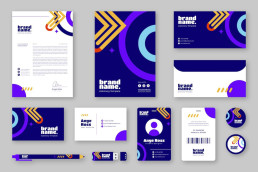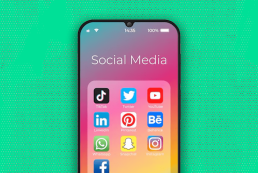How to Create a Brand Identity that Resonates
Your brand identity is more than just a logo—it’s the personality of your business. It communicates who you are, what you stand for, and why customers should care. Understanding how to create a brand identity involves diving into the art and psychology of design, paired with a deep connection to your mission and vision.
At Blue Ridge Creative Marketing, we ensure every client has either a simple or comprehensive brand style guide before we start working on web design, social media strategy, email marketing, or any other project. This ensures consistency and a strong foundation for every aspect of your brand.
1. Start with Your Mission and Vision
Before exploring how to create a brand identity, reflect on the “why” behind your business.
Mission Statement: What do you do, and who do you serve? A strong mission statement should be clear and actionable.
Vision Statement: Where do you want your business to go? This provides direction and inspiration.
For example, if your mission is to provide eco-friendly products for families, your brand identity should exude trust, sustainability, and care.
2. The Psychology of Color
Colors evoke emotions and set the tone for your brand. Learning how to create a brand identity includes understanding the psychology of color to align your visual identity with your values.
Blue: Trust, reliability, and professionalism. Great for corporate or tech brands.
Green: Growth, sustainability, and health. Ideal for eco-conscious or wellness-focused businesses.
Red: Passion, energy, and urgency. Works well for bold, dynamic brands.
Yellow: Optimism, creativity, and warmth. Perfect for playful or family-oriented brands.
Pro Tip: Pair Colors Strategically
Use a primary color for your logo and main branding elements. Add complementary colors for accents. Tools like Adobe Color or Canva’s color wheel can help you find perfect pairings.
3. Choose Fonts That Speak for Your Brand
Fonts, like colors, carry emotional weight. Mastering how to create a brand identity means choosing fonts that match your business’s tone and personality.
Serif Fonts (e.g., Times New Roman): Classic, sophisticated, and trustworthy. Great for traditional or professional brands.
Sans-Serif Fonts (e.g., Arial): Clean, modern, and approachable. Often used by tech and minimalist brands.
Script Fonts (e.g., Brush Script): Elegant and personal, suitable for creative or luxury brands.
Display Fonts: Unique and bold, ideal for businesses with a playful or unconventional edge.
Pro Tip: Limit Your Font Choices
Stick to two or three fonts to maintain consistency. Use one for headings, another for body text, and possibly a third for accent pieces.
4. Incorporate Symbolism
Learning how to create a brand identity also involves leveraging industry-specific symbols and imagery. These elements help visually communicate your brand’s story and connect with your target audience.
Healthcare: Symbols like crosses, hearts, or hands represent care, healing, and humanity.
Technology: Abstract designs and futuristic icons signal innovation and modernity.
Hospitality: Warm imagery like suns or waves evokes a welcoming atmosphere.
Retail: Shopping carts or tags connect directly to commerce.
Education: Books and lightbulbs symbolize learning and growth.
5. Bring It All Together
Once you’ve explored how to create a brand identity, ensure consistency across all touchpoints. From your website to social media to printed materials, your brand identity should be instantly recognizable.
- Logo Design: Combine your elements into a simple, versatile logo.
- Brand Guidelines: Whether simple or comprehensive, your style guide should outline your colors, fonts, logo usage, and tone of voice.
Final Thoughts
Mastering how to create a brand identity is both an art and a science. By blending psychology, design principles, and a clear sense of purpose, you can craft a brand that not only looks good but also connects emotionally with your audience.
At Blue Ridge Creative Marketing, we make sure your brand is set up for success. With a simple or comprehensive brand style guide as the cornerstone, we’ll help you achieve a consistent, recognizable presence before diving into web design, social media strategy, email marketing, and beyond.
Ready to learn more about how to create a brand identity? Contact Blue Ridge Creative Marketing—we’ll help you bring your vision to life!
How to Improve SEO: 5 Tips Anyone Can Do
Boosting your website’s visibility can be simple if you know where to start. If you're wondering how to improve SEO, here are five actionable tips you can implement right away to start seeing results. And for the more technical aspects, our team is ready to assist!
1. Publish Fresh Content Regularly
Why It Helps: Consistent, relevant content is a strong indicator to search engines that your site is active and valuable, which can boost your ranking.
How to Do It:
-
- Start a Blog: Write about topics related to your business, answer customer FAQs, or share industry news. Aim for quality over quantity—try to post at least once a week if possible, but make sure it’s valuable content.
- Update Existing Content: Periodically revisit old blog posts to add new statistics, links, or updated information. This not only keeps them relevant but also signals to search engines that the content is fresh.
- Create a Content Calendar: Plan content in advance around key themes or events in your industry to keep your blog consistent.
2. Use the Right Keywords Naturally
Why It Helps: Keywords help match your content to specific search queries, making it easier for search engines to find and rank your website.
How to Do It:
-
- Keyword Research: Use free tools like Google’s Keyword Planner, Ubersuggest, or AnswerThePublic to find relevant keywords. Look for terms that have a good search volume but aren’t overly competitive. If you're willing to pay for a subscription, try out SERanking, SEMrush or Ahrefs. You can use YouTube to learn how to use these for keyword research.
- Placement Matters: Use your main keyword in your title, introduction, headers, and image alt tags. For example, if your main keyword is “how to improve SEO,” include it naturally throughout your post but avoid “keyword stuffing” (overloading with keywords).
- Use Long-Tail Keywords: Target specific phrases people might search for, like “best SEO tips for small businesses.” These phrases have less competition and help capture more targeted traffic.
3. Optimize for Mobile Users
Why It Helps: With over half of all web traffic coming from mobile devices, search engines prioritize mobile-friendly websites. Ensuring your site works well on mobile can improve your ranking.
How to Do It:
Mobile-Friendly Design: Use a responsive design that adapts to any screen size. WordPress is our go-to platform, and offers mobile-responsive templates.
Run Mobile Tests: Use Google’s Mobile-Friendly Test to see how your site performs on mobile devices and get tips on fixing issues.
Speed Up Load Times: Compress images, reduce the number of large files, and consider using a content delivery network (CDN), such as Cloudflare, to improve load speeds on mobile. You can use plugins to do these on your WordPress website, but be careful to check the reviews. Some plugins can crash your website. Backing up your website first is key in case it doesn't jive your template.
4. Use Internal Links
Why It Helps: Internal links create a web of content within your site, helping search engines understand your site’s structure and spreading SEO “link equity” across pages.
How to Do It:
-
- Link Strategically: Link to relevant pages or posts within your content. For example, if you mention a specific service, link to its page to provide more information.
- Anchor Text Optimization: Use descriptive keywords in your anchor text (the clickable text of the link) rather than vague phrases like “click here.”
- Plan Link Paths: With a list of high-traffic and cornerstone pages, link to these pages often to drive more traffic and share authority.
5. Write for Humans, Not Just Search Engines
Why It Helps: Search engines increasingly prioritize content that offers real value to readers, which means that high-quality, engaging content can give you an SEO boost.
How to Do It:
-
- Write Conversationally: Use simple, conversational language that’s easy for readers to understand. Avoid overly technical terms unless necessary.
- Use Subheadings and Bullet Points: These break up your content, making it easier for readers to scan. Search engines also recognize this structure, which can improve SEO.
- Answer Questions: Address common questions people might ask about your topic. This can help you rank for “People also ask” boxes in search results, which will improve SEO and brings more visibility.
No Time for SEO?
Feeling overwhelmed by the demands of SEO? You’re not alone! Many businesses struggle to keep up with the ever-evolving world of search engine optimization. But don’t worry—Blue Ridge Creative Marketing is here to help you elevate your online presence without adding to your already full plate. Contact us today to get started!
[/vc_column_text][/vc_column][/vc_row]
Cracking the Social Media Algorithm: Tips for Getting More Likes
Let’s be real: capturing attention online today is like trying to get the whole room’s focus when everyone’s looking at their phones. With endless content scrolling by and every brand fighting for a moment in the spotlight, it’s getting harder to stand out. Traditional posts just don’t have the same magic they used to, and social media algorithms are tougher to win over.
But here’s the good news: there are some tried-and-true ways to stay on the algorithm’s good side and get your brand noticed. It’s about smart engagement, boosting at the right times, and connecting with your community. Here’s how to tackle it and get your brand where it belongs—in front of more people.
1. Invite People to Like Your Page Through Content Engagement
Each time someone interacts with your content on Facebook but doesn’t yet follow your page, you can use the “Invite to Like” option. For example, go to a post of yours that did really well. Click on the number of likes. You will see an option to "invite to link" on anyone who came across the image but isn't yet following you. Now you've encouraged them to follow to get more from you.
2. Engage on And Off Your Profile
Algorithms love when brands actively engage with their audience. And that means not just waiting for people to come to you—go out and connect with others in your industry or community! Join groups relevant to your industry (there is something for everyone!), like the posts or comment on posts of members of your community (maybe they didn't know you exist!), find new people who moved to town and say hello and let them know of your services
3. Partner With Local Businesses
Teaming up with other local businesses is more than just smart networking—it’s a great way to show the algorithm that you’re a real, involved part of the community. Plus, collaboration gets your brand in front of an entirely new audience.
Ideas for collaboration:
- Cross-promote each other’s posts in your stories.
- Host a giveaway together.
- Tag local businesses and show them some love in your posts.
When you engage with other brands in your area, you’re building a network that makes you more visible and establishes your profile as a trusted source in your community.
4. Boost Key Posts (Even if It’s Just a Few Bucks)
In a pay-to-play world, organic reach only gets you so far. For posts that you want to see take off—like announcements, events, or launches—a small boost can be the nudge you need. Even a few bucks on a well-performing post can make a difference, helping you get in front of more people who actually care about your brand. Plus, the algorithm is more likely to prioritize your profile for organic content too as it signals to Facebook that the page is investing in maintaining an active, engaging presence.
Ready to Take Control of Your Visibility and Crack the Social Media Algorithm?
With these straightforward tips, you don’t need a huge budget or an all-hands-on-deck approach to crack the social media algorithm. It’s about showing up authentically, connecting with your community, and being smart with the tools that are already available. Start simple, but stay consistent—soon enough, you’ll see the difference in your reach and engagement.
At Blue Ridge Creative Marketing, we know the ins and outs of making the algorithm work for you. From content strategies to audience engagement tips, we’re here to help you make your mark. Ready to grow your brand’s online presence? Ask us our about our social media management service today! Email aaron@weareblueridge.com to get a quote.
[/vc_column_text][/vc_column][/vc_row]
Launching a New Website: How to Promote It
Launching a new website is an exciting milestone! However, the real work begins after the site goes live. At Blue Ridge Creative Marketing, we know that a successful website launch is not just about the design and functionality but also about how you promote it to reach your audience effectively. Here are some essential steps to take when launching a new website and how to promote it for maximum impact.
1. Announce Your Launch
Email Marketing: Send an email to your existing subscribers announcing your new website. Highlight the new features, improved user experience, and any special offers related to the launch.
Social Media: Utilize all your social media channels to announce the launch. Create engaging posts with visuals or videos showcasing your new site and its benefits. At Blue Ridge, we can provide you with social media graphics and captions to post when you launch on a weekly basis to create a buzz.
Press Release: Consider writing a press release and distributing it to relevant media outlets. This can help you reach a broader audience and get some buzz around your new site.
Business Listings: Make sure you add your new website URL to Google My Business, Yelp, Facebook, LinkedIn, Psychology Today, or wherever else you have a profile.
2. Engage Your Audience
Interactive Elements: Add interactive elements like polls, quizzes, or surveys to engage your audience and get their feedback on your new site.
Customer Testimonials: Feature customer testimonials and success stories to build trust and credibility with your audience.
3. Utilize Paid Advertising
Google Ads: Set up Google Ads campaigns targeting keywords related to your business. This can help drive immediate traffic to your new site.
Social Media Ads: Use social media advertising on platforms like Facebook, Instagram, and LinkedIn to reach a wider audience. Target users based on demographics, interests, and behaviors.
4. Monitor and Analyze Performance
Analytics Tools: Set up analytics tools like Google Analytics to monitor your website’s performance. Track metrics such as traffic, bounce rate, and ppl conversion rates to understand how your site is performing.
Heatmaps: Use heatmaps to see how users are interacting with your site. This can help you identify areas that need improvement and optimize the user experience.
Feedback Forms: Implement feedback forms to gather user insights and suggestions. This can help you make necessary adjustments and improvements.
Launching a new website is just the beginning. By following these steps and actively promoting your site, you can ensure that your new website reaches its full potential and drives growth for your business. At Blue Ridge Creative Marketing, we’re here to help you every step of the way. Contact us to learn more about how we can support your website launch and promotion efforts.





